
Some of you may be aware that Spink's of London will be selling by auction, my collection of Anglo-Boer
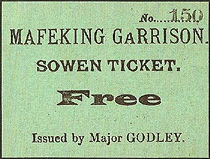
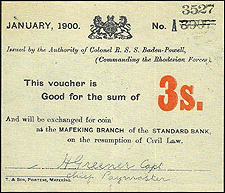 War Paper Currency on 12-13 April. Of particular
interest to Scout collectors will be the Mafeking
Banknotes, including a number of varieties, as
well as Soup and Sowen tickets. Most items
are being sold individually with over 160 lots, and on
checking my records I see that some of these
I purchased from former SGSC members over 50
years ago. It will be sad to see them sold, but at
the age of 82, I trust other people will have
pleasure in owning a great part of pre-Scouting history, as without the Siege of Mafeking, it is very unlikely
that Baden-Powell would have ever started Scouting.
War Paper Currency on 12-13 April. Of particular
interest to Scout collectors will be the Mafeking
Banknotes, including a number of varieties, as
well as Soup and Sowen tickets. Most items
are being sold individually with over 160 lots, and on
checking my records I see that some of these
I purchased from former SGSC members over 50
years ago. It will be sad to see them sold, but at
the age of 82, I trust other people will have
pleasure in owning a great part of pre-Scouting history, as without the Siege of Mafeking, it is very unlikely
that Baden-Powell would have ever started Scouting.
My "Jottings" for the Winter 2015 issue of our Bulletin proved to be of interest, especially to our Canadian
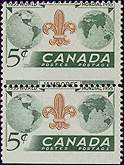
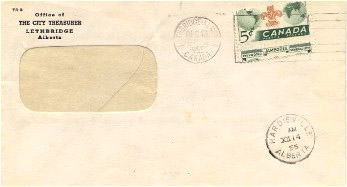 members when I showed a badly perforated
1955 Jamboree stamp. Thanks to both Alex
Hadden and Tony Manson, I can now show
two more items from their collections
including possibly the only known cover
with this variety. If you have any interesting
varieties of Scout stamps, why not share them with our members.
members when I showed a badly perforated
1955 Jamboree stamp. Thanks to both Alex
Hadden and Tony Manson, I can now show
two more items from their collections
including possibly the only known cover
with this variety. If you have any interesting
varieties of Scout stamps, why not share them with our members.
A few months ago, I gave a display of my U.K. Scout collection to a local Philatelic Society, and when it
came to the 1957 World Jamboree set, I asked the audience how many issues of commemorative stamps had
been issued since the Coronation of Queen Elizabeth II in 1953. By then four years had passed, and knowing
how many sets our Post Office issues these days, the answers were all wrong. The World Jamboree stamps
were the first set to be issued in four years. It then came to the 1957 coils, and the members were most surprised
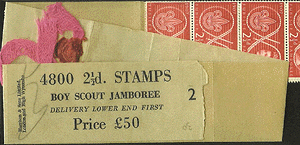 to learn that the Scout issue was the first and only set of
U.K. commemorative stamps to be produced in coils. At
the time the Post Office was informed to expect to sell
some two million covers, so they commissioned a special
machine for applying the set of three stamps. What the Post
Office did not realise was that many people and companies
produced their own First Day Covers, so in the end only
60,632 official covers were stamped and sold by the Post
Office. The machine required the stamps to be in
continuous rolls, so an order was placed with the printer for
these to consist of 4800 stamps. The following were produced for the machine and for sale at the London Chief
Office, 2½d...487, 4d...480 and 1s.3d...482, but due to the lack of sales, only just over 20 rolls were sold of each
value. As the Post Office had a considerable number of rolls left, it was found that the quantities were too large
for stamp collectors, so some were rewound into smaller rolls of 480 for the 2½d and 4d and 240 for the 1s.3d
to learn that the Scout issue was the first and only set of
U.K. commemorative stamps to be produced in coils. At
the time the Post Office was informed to expect to sell
some two million covers, so they commissioned a special
machine for applying the set of three stamps. What the Post
Office did not realise was that many people and companies
produced their own First Day Covers, so in the end only
60,632 official covers were stamped and sold by the Post
Office. The machine required the stamps to be in
continuous rolls, so an order was placed with the printer for
these to consist of 4800 stamps. The following were produced for the machine and for sale at the London Chief
Office, 2½d...487, 4d...480 and 1s.3d...482, but due to the lack of sales, only just over 20 rolls were sold of each
value. As the Post Office had a considerable number of rolls left, it was found that the quantities were too large
for stamp collectors, so some were rewound into smaller rolls of 480 for the 2½d and 4d and 240 for the 1s.3d
 and placed on 2nd
September 1957.
The total amount
sold was 49 of the
2½, 37 of 4d and
33 of the 1s.3d
value. To prove
that stamps came
from coils, you had
to collect the coil leaders as shown or find a strip of 21 stamps, as the original sheets consisted of 6 x 20
stamps.
and placed on 2nd
September 1957.
The total amount
sold was 49 of the
2½, 37 of 4d and
33 of the 1s.3d
value. To prove
that stamps came
from coils, you had
to collect the coil leaders as shown or find a strip of 21 stamps, as the original sheets consisted of 6 x 20
stamps.
|



